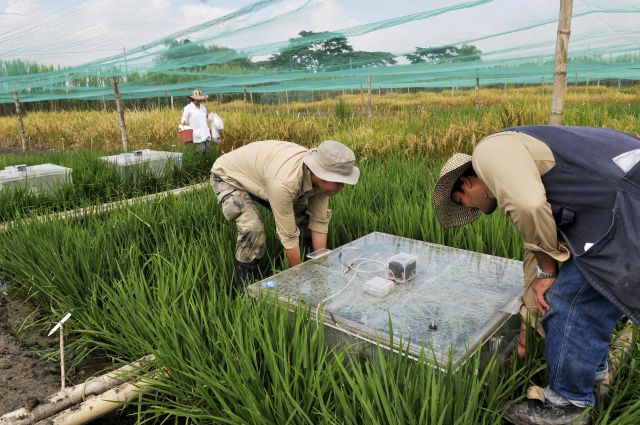
Title
PRESS RELEASE - May 29, 2014
SÃO PAOLO//WASHINGTON (May 29, 2014) – The World Resources Institute unveiled the first ever Agricultural Guidance to help companies measure, manage, and report greenhouse gas emissions from the agriculture sector, including farming, livestock, and land use change. The agriculture sector is responsible for 17 percent of global GHG emissions, including land use change. However, 75 percent of agricultural producers targeted by CDP do not report their emissions.
“The agriculture sector is one of the most important areas when it comes to greenhouse emissions, accounting for nearly one-fifth of global total,” said Dr. Andrew Steer, President and CEO, WRI. “We are no longer driving blind when it comes to these emissions. Now, agricultural companies can better measure and manage their emissions, enabling them to feed the world and improve livelihoods for farmers. In agriculture-rich countries, like Brazil, this guidance will be a boon to businesses looking for smart strategies to drive sustainable food production.”
Unlike industrial sectors, agricultural emissions are strongly influenced by environmental conditions, such as soil moisture content and temperature. For this reason, it has been difficult to separate man-made effects from natural ones and to obtain accurate emissions data. There have also been large uncertainties when calculating changes in carbon emissions due to land use and land-use change, which made agricultural activities even harder to measure.
“Until now, the absence of a globally accepted methodology hindered GHG reporting in the agricultural sector,” said Dr. Stephen Russell, Senior Associate, WRI, lead author of the Agriculture Guidance. “The new guidance will help ensure greater consistency and confidence in GHG inventory practices for agricultural companies, as well as more effective reduction strategies.” Developed by the GHG Protocol, the Agricultural Guidance is the first globally harmonized framework for businesses, providing them with a comprehensive view of their agricultural emissions. The guidance will drive critical management activities including identifying emissions reduction opportunities, setting reduction targets, and reporting to stakeholders. Because reducing emissions can help increase farm productivity and reduce the costs of farm inputs, the guidance offers a way to contribute to more sustainable economic growth.
“With no standards in this area, companies have struggled to account for their agricultural emissions, irrespective of whether they are agricultural producers themselves or companies with agricultural supply chains. We need to raise awareness of the significant emissions that arise within this sector,” said Nigel Topping, Executive Director, CDP. “The new GHG Protocol Agricultural Guidance is the standardized methodology companies have been seeking and we expect many more agricultural companies to report their emissions using this guidance. Greater disclosure from agricultural companies is a critical first step in addressing this issue; as only through understanding where emissions arise can these companies start to reduce emissions.”
The Agricultural Guidance was developed over a two-year, global consultation process involving over 100 experts from multi-national companies, family farms, government agencies, academia, and NGOs. The guidance has been road tested by leading agribusinesses in Brazil and is expected to stimulate emissions management practices across their extensive supply chains. The road test companies included: Bunge, the largest Brazilian agribusiness exporter; AMAGGI, one of the world’s largest soy and corn producers; JBS, the world’s largest animal protein processing company; and Marfrig, one of the world’s top meat producers and beef processors.
“To AMAGGI, the GHG Protocol Agriculture Guidance is an important tool to measure emissions specific to the agricultural sector, bringing more transparency and quality to the calculation of those emissions,” said Juliana Lopes, Director of Sustainability, AMAGGI. “For Brazil, which is one of the main producers of grains in the world, it is fundamental to have this tool. And that is why AMAGGI pioneered the use of the GHG Protocol Agriculture Guidance and has already published its emissions inventory in 2013 incorporating new sources of emissions uncovered during the pilot program.”
In addition to the Agricultural Guidance, the GHG Protocol is launching an emissions calculation tool specifically for Brazilian companies. Brazil is the world’s fifth largest GHG emitter, largely due to emissions from agriculture (35 percent) and land use change in the Amazon and Cerrado (22 percent). Well over 90 percent of deforestation emissions in Brazil are caused by agriculture. The Brazilian Emissions Calculation Tool provides specific instructions to calculate emissions from the highest-emitting subsectors in Brazil, including cattle ranching, soy, and sugar cane production, as well as land use change. The tool was developed through a collaboration among WRI, Embrapa (Brazilian Agricultural Research Corporation), and Unicamp (State University of Campinas).
“As deforestation in the Amazon has been reduced, GHG emissions in agriculture have taken a more important role in Brazil’s national inventory. Agriculture is now responsible for one-third of Brazil’s GHG emissions, which can be reversed, but the first step is to know how much is being emitted,” said Professor Eduardo Assad, Senior Researcher from Embrapa, the Brazilian’s government agricultural research Institute. “Soya, corn, rice, beans, sugar cane and livestock producers are now able to use WRI's tool to measure the CO2 emitted for each product. This is an important step for certification of Brazilian commodities, so our products can be more competitive and gain an environmental label. The world is going in this direction and it is a great opportunity to be able to have the first GHG Protocol of Agriculture in the world.”
“Brazil is a major commodities exporter and these new tools will support companies and businesses that are taking action to reduce their GHG emissions,” said Rachel Biderman, Director, WRI Brasil. “As the world moves toward sustainable food production, this guidance will help companies to be more competitive and drive greater innovation in the market.”
The Agriculture Guidance is a supplement to the GHG Protocol Corporate Accounting and Reporting Standard, the leading international standard for corporate GHG inventories, which was created by WRI and the World Business Council for Sustainable Development (WBCSD).
The new guidance and tool are available at: ghgprotocol.org.